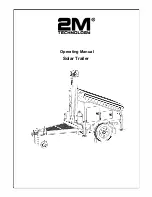
1. Acquire an outdoor underground cable long enough to reach from the
junction box (K) on the column to the nearest fuse box inside the house. A
1-phase system needs a cable with two wires plus a surrounding shield
(1-phase cable), whereas a 3-phase system needs a cable with four wires
plus the shield (3-phase cable). The thickness of the wires should be at least
2.5mm² for cable lengths up to 40 meter or 6mm² for cable runs up to 100
meter. Indoor cable sections can use an indoor cable of the same size and
with the same number of conductors. Please consult your electrician for the
exact cable to use according to local code requirements.
2. Wire the cable from the junction box (K) to the fuse box. A strong string
can be used to pull the cable up through the bottom of the column and
out of the hole beneath the junction box. It is recommended to pull under-
ground sections through a cable duct. The duct needs to be burried so
that the top of the duct is 35 cm below ground. If the cable runs over bed-
rock it needs to be protected by a strong hose (or a metal U-profile).
3. Make sure that all cable sections above ground are properly attached
and protected so the cable cannot be accidentally moved or damaged.
Sections coming out of the ground need to be protected by for example
a metal U-profile.
4. Fill out and attach the included self adhesive warning labels. These labels
need to be provided near the solar installation, the fuse box, and the utility
meter, to indicate the presence of on-site generation and the placement
of the AC switch (S).
Contact a certified electrician and have them inspect the installation
and carry out the remaining tasks.
1. Make the electrical connections as illustrated on the previous page.
2. Connect the AC cable to the selected phase(s) through fuse(s) in the
fuse box.
3. Connect the solar panels to the PV input terminals of the microinverters.
4. Turn on the AC switch (S) in the junction box to power the inverter(s) and
solar tracker. It takes a few minutes for the tracker to find a GPS signal
before it start to track the sun.
5. Check the status lights on the inverter(s). When a solar panel is connec-
ted its LED becomes red. When the AC side is connected and powered the
LED starts blinking red. Grid feed-in starts after about 30 seconds during
sunshine indicated by the LED either blinking green (optimizing output) or
being continously green (output optimized).
Grid-�ed system with microinverters
Содержание HELIOMOTION PV-6
Страница 1: ...QUICK ASSEMBLY GUIDE PV 6 HELIOMOTION HelioZenit Revision 1 2021...
Страница 2: ...1x 1x PART I FOUNDATION...
Страница 6: ...1x 1x 6x 4x PART II TRACKER...
Страница 7: ...6x 4x 1x 1x 1 2...
Страница 8: ...2x 1x 1x 20x 2x 4x 8x 1x 2x 2x 4x PART III FRAMEWORK...
Страница 9: ...2300mm 2000mm 150mm 150mm 2x 2x 4x 2 1...
Страница 10: ...2x 960mm 960mm 2x 45mm 45mm 4 3...
Страница 11: ...592mm 592mm 1x 1x 4x 1 2 1x 5 6...
Страница 12: ...16x 45mm 600mm 600mm 45mm Tighten the M16 nut slightly on both sides 8 7 1 2...
Страница 13: ...645mm 645mm X 1324mm X X Panel width 3 1324 2 4x 9...
Страница 14: ...6x 10x 10x 24x PART IV PANELS...


































